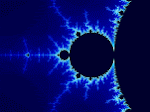
This is a nebula. I heard someone on TV (I forget who or what TV program) mention the term "nebulous objects" and it struck my fancy since I've been thinking so much about objects in general. According to the website here: Originally, the word "nebula" referred to almost any extended astronomical object (other than planets and comets). The etymological root of "nebula" means "cloud". As is usual in astronomy, the old terminology survives in modern usage in sometimes confusing ways. We sometimes use the word "nebula" to refer to galaxies, various types of star clusters and various kinds of interstellar dust/gas clouds. More strictly speaking, the word "nebula" should be reserved for gas and dust clouds and not for groups of stars.
But nebulous, I think, has interesting connotations. According to the American Heritage dictionary (I woould look it up in the OED, but can't get it online unless I'm at school, darn it!) nebulous means: Cloudy, misty, or hazy. 2. Lacking definite form or limits; vague: nebulous assurances of future cooperation. 3. Of, relating to, or characteristic of a nebula.
I'm particularly struck by the second definition, which moves from the material haziness given in the physical descriptors of the first definition, to an uncertain state of subjective intention: "nebulous assurances of future cooperation." This sentence seems to move into a kind of politics where "nebulous subjects" or the nebulousness of subjectivity can only give "nebulous assurances." Politics here is then an openness or formlessness that, while it can provide only "cloudy" assurances, is also dynamic and, as indicated by the image above, might even be expressively beautiful. (I use the term "expressive" here in a Deleuzian sense, which would exceed any specificity of the subject). The nebulae that form (or are formed by) galaxies, which stand in uncertain relation to space and time (they continally move and shift) , in the movement of this definition itself, inform or transform our sense of social relations. That is, how we construct our sense of politics and subjective intention is determined by our relationship to objects on the vastest and the most microscopic scales. I am reminded of the surrealist object, as well as the surrealist approach to the object. One of my favorite descriptions of the surrealist method is by the sadly overlooked author, Leonora Carrnington. "The task of the right eye," she tells us, "is to peer into the telescope, while the left eye peers into the microscope." This task of incommensurable vision is, I would think, only potentially performed by an expansion of our concept of subject/object relations. N'est pas?



No comments:
Post a Comment